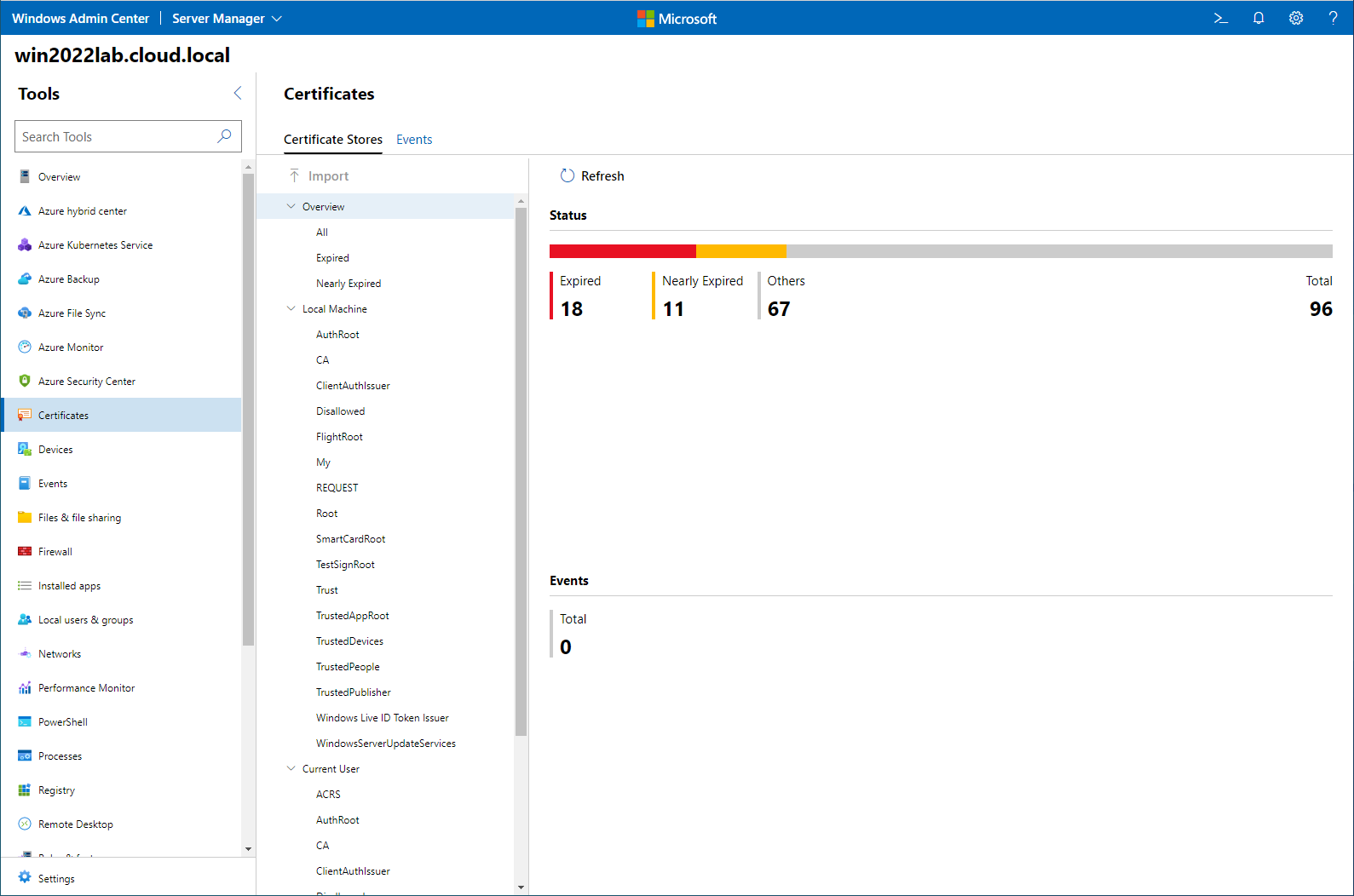Windows Server 2022 is the most sophisticated and advanced Windows Server operating system to date. If you haven’t heard about all the new features, see our post about Windows Server 2022 new features. Many of the powerful new features found in Windows Server 2022 are made possible by Microsoft’s new management platform for modern Windows Server OS – Windows Admin Center.
What is Windows Admin Center? How can IT admins manage Windows Server 2022 with Windows Admin Center? First, let’s take a closer look at this new management solution and how it enables administrators to get the most out of both on-premises and hybrid infrastructure.
What is Windows Admin Center (WAC)?
Most are now well versed in using the legacy Server Manager utility that has been around since Windows Server 2008. Microsoft overhauled Server Manager in Windows Server 2012 to support remote, multi-server management and help increase the number of servers an administrator can manage.
For quite some time, the writing has been on the wall that Server Manager is getting “long in the tooth” for managing servers at scale and effectively combining all the consoles and features needed for on-premises servers. Additionally, it lacks hybrid cloud capabilities and tooling required for the modern enterprise environment leveraging cloud infrastructure.
With the needs of the modern enterprise transcending beyond the capabilities of Server Manager, coinciding with the release of Windows Server 2019, Microsoft released Windows Admin Center. Windows Admin Center is a modern management tool that provides many features, capabilities, and management architecture missing in the legacy Server Manager tool.
What is Windows Admin Center exactly? Windows Admin Center is a lightweight tool that is locally deployed and is browser-based. As you can imagine, browser-based tools provide much more flexibility with access and better performance.
Windows Admin Center allows managing a wide range of infrastructure, including standard Windows Servers, Windows Servers clusters, hyper-converged clusters (HCI), and Windows 10 PCs.
With Windows Admin Center, IT admins get a new experience of managing Windows Servers with the following benefits:
- Modernized look and feel – The tool is a modern take on the familiar tools that admins use today in Server Manager. The contemporary management architecture from a browser allows admins to access management dashboards and tools from a web browser on any device, aligning with and allowing admins the management flexibility needed in today’s diverse environments.
- Simplified hyper-converged infrastructure management (HCI) – From a very straightforward interface workflow, admins can have a streamlined workflow to create and manage HCI clusters and virtual machines, Storage Spaces Direct (S2D), and software-defined networking.
- Hybrid features built-in – Windows Admin Center has hybrid features built-in. You can easily connect and interact with Microsoft Azure and also connect on-premises resources with Microsoft Azure.
- Lightweight – The download of Windows Admin Center is around 60 MB. It does not require any agents to be installed.
- Available in the cloud – Windows Admin Center is now available natively to use inside your Azure portal to manage your infrastructure in the cloud
- Extendable framework – Windows Admin Center is extendable. With a modular design that supports “extensions,” third parties can write extensions to work with Windows Admin Center. So with Windows Admin Center, you have an ala carte of extensions to choose from, allowing you to add the extensions you need.
The new Windows Admin Center management tool provides the modern management platform and integration with Microsoft Azure, allowing organizations to manage, configure, and integrate Windows Server 2022 to the fullest extent possible.
Exclusive functionality in Windows Admin Center
Starting with Windows Server 2019, Windows Admin Center is the new recommended Windows Server management tool moving forward. Aside from being the recommended tool for modern Windows Server management, there is also exclusive management UI functionality found in Windows Admin Center not available in any other GUI-based tool. These features include:
- Storage Migration Services
 Storage Migration Service dashboard available in Windows Admin Center
Storage Migration Service dashboard available in Windows Admin Center
- System Insights
 System Insights provides anomaly detection and other valuable health metrics
System Insights provides anomaly detection and other valuable health metrics
- Software-Defined Networking (SDN)
 SDN extensions available in Windows Admin Center for Managing Windows Server 2022
SDN extensions available in Windows Admin Center for Managing Windows Server 2022
Having the ability to have GUI management tools to install, configure, and manage these features and capabilities with the WAC GUI aligns with how IT admins have managed Windows Servers historically.
Removing blockers to Windows Server 2022 Core
Arguably, one of the essential benefits of Windows Admin Center is it removes blockers for Windows Server 2022 Core adoption. Windows Server Core is Microsoft’s GUI-less operating system that drastically reduces the footprint of the Windows Server operating system, both from an attack surface and disk space perspective.
 Installing Windows Server 2022 Core
Installing Windows Server 2022 Core
With Windows Server Core, IT admins can achieve an almost “Linux-like” experience perfect for production environments and other mission-critical infrastructure such as HCI servers. Unfortunately, the lack of tooling and effective management of Windows Server Core has long been a blocker to the widespread adoption of Windows Server Core operating systems.
 Windows Server 2022 Core SConfig interface
Windows Server 2022 Core SConfig interface
Now, with Windows Admin Center, the management and tooling blockers for leveraging Windows Server 2022 Core are removed. Windows Admin Center allows admins to have the advanced tools and interfaces needed for management. Combined, Windows Server 2022 Core and Windows Admin Center provide a modern Windows Server and management platform moving forward.
Visibility and configuration of Secured-core Server
While it is one of many features that Windows Admin Center allows installing, managing, and configuring in Windows Server 2022, let’s start with core security features. Secured-core server is officially introduced with Windows Server 2022. A Secured-core Server is a modern Windows Server 2022 device containing the highest level of hardware, software, and identity protection ready out of the box. It protects the boot process with the hardware root-of-trust. The protection afforded by the hardware root of trust coupled with protections found in modern CPUs helps to protect against current threats.
Secured-core server defends against firmware-level attacks by using hardware-level security in the modern CPU to launch the system into a trusted state, preventing advanced malware from attacking at the firmware level with unverified code. Once the CPU is instantiated safely, the OS takes control. In addition, hypervisor-enforced code integrity ensures that all code in the OS kernel is trustworthy.
In addition, Windows Admin Center makes installing, configuring, and managing Secured-core features easy to do in a single location. Let’s look at the new Windows Admin Center security dashboard and see how it is easy to view the components and status of Secured-core features.
In the security dashboard in Windows Admin Center, you will see the Secured-core tab. The Secured-core tab aggregates all of the required security technology configurations in a single view. In addition, it displays whether the technology is available, enabled, and configured. Any that are not enabled are noted as shown below.
 Viewing the Secured-core configuration in Windows Server 2022 with Windows Admin Center
Viewing the Secured-core configuration in Windows Server 2022 with Windows Admin Center
As an example of how Windows Admin Center allows configuring the technologies, in the view below, HVCI is not enabled. However, after highlighting it, you will see the ability to Enable the technology if it is supported.
 Enable missing Secured-core configuration in one click with Windows Admin Center
Enable missing Secured-core configuration in one click with Windows Admin Center
After enabling, Windows Admin Center will note any reboots needed. In this way, Windows Admin Center provides an easy way to interact with Secured-core technologies, making these easy and accessible.
 Windows Admin Center finalizing Secured-core configuration
Windows Admin Center finalizing Secured-core configuration
In addition to Secured-core technologies, the Security extension in Windows Admin Center allows viewing and configuring malware scans and scan history. In addition, it enables seeing real-time protection status is enabled and allows performing ad-hoc scans and scheduling new scans.
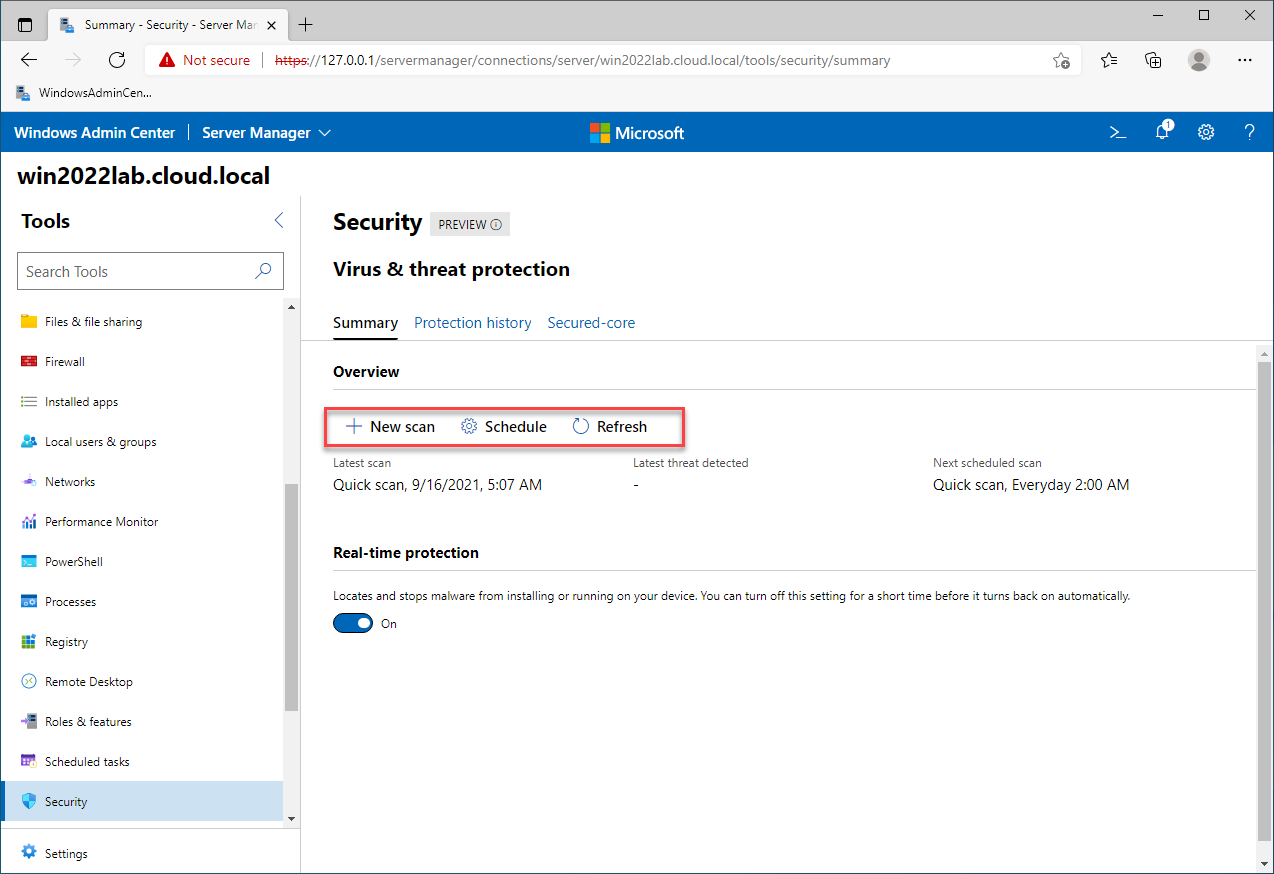 Windows Admin Center provides visibility to built-in Windows Defender scans
Windows Admin Center provides visibility to built-in Windows Defender scans
One of the day-to-day Windows Server administration tasks admins are involved with is managing users and groups configured in Windows Server. The Local users and groups extension provides the ability to create new users, manage memberships, delete users, and view other pertinent information.
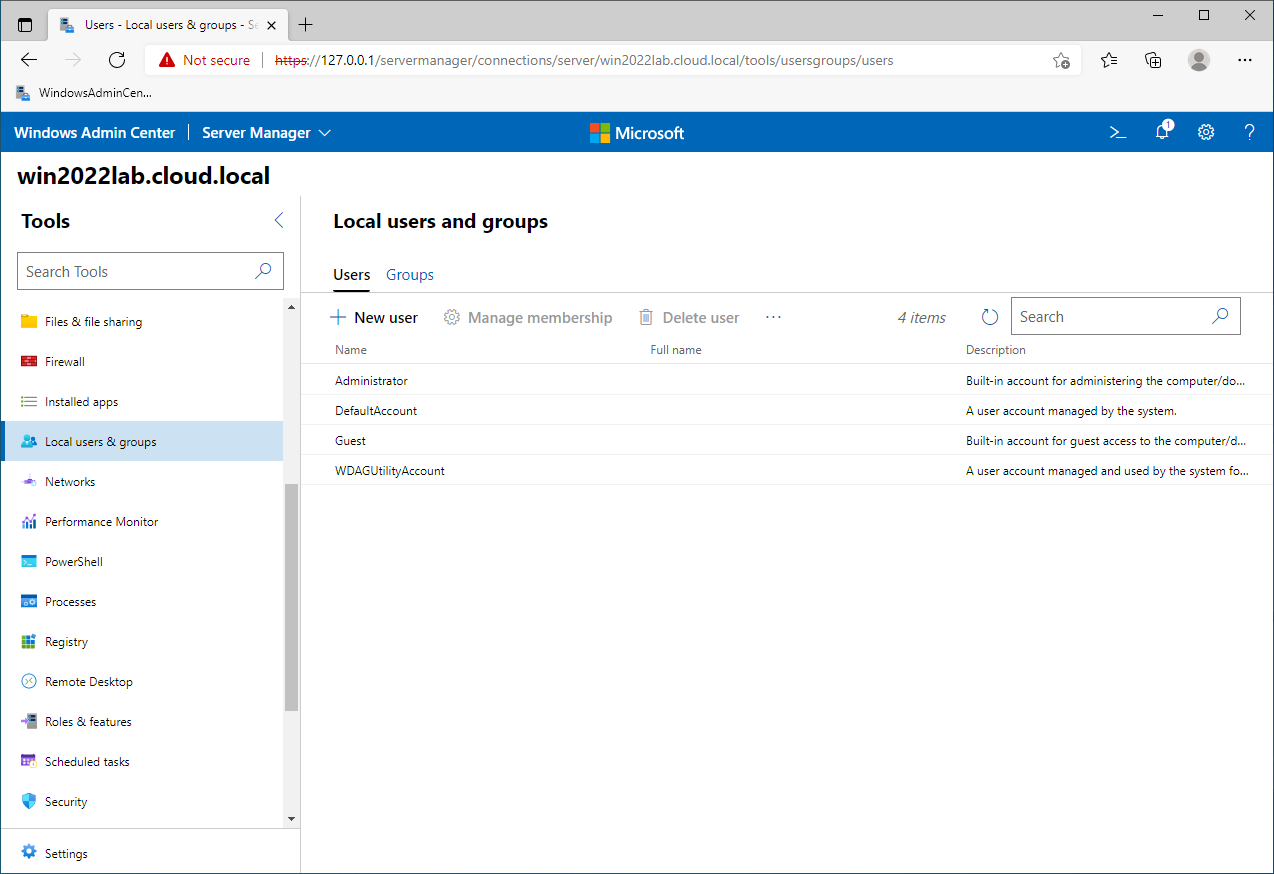 Manage Windows Server 2022 Local Users and Groups in Windows Admin Center
Manage Windows Server 2022 Local Users and Groups in Windows Admin Center
What about managing your network configuration? Windows Admin Center provides a great view of your network configuration. You can view all of the crucial network information in a single-pane-of-glass display. In addition, touching on hybrid capabilities, the Networks extension allows quickly and easily adding an Azure Network Adapter to your Windows Server 2022 server.
What is the Azure Network Adapter? The Azure Network Adapter creates a point-to-site VPN connection to Microsoft Azure, making this an effortless way to “plumb in” your Windows Server 2022 server without the need for setting up complex global VPN connections for your site.
This new network capability was first introduced with Windows Server 2019. It gives IT admins more choices and tools to solve complicated network connectivity issues in hybrid cloud environments where resources span from on-premises to Azure.
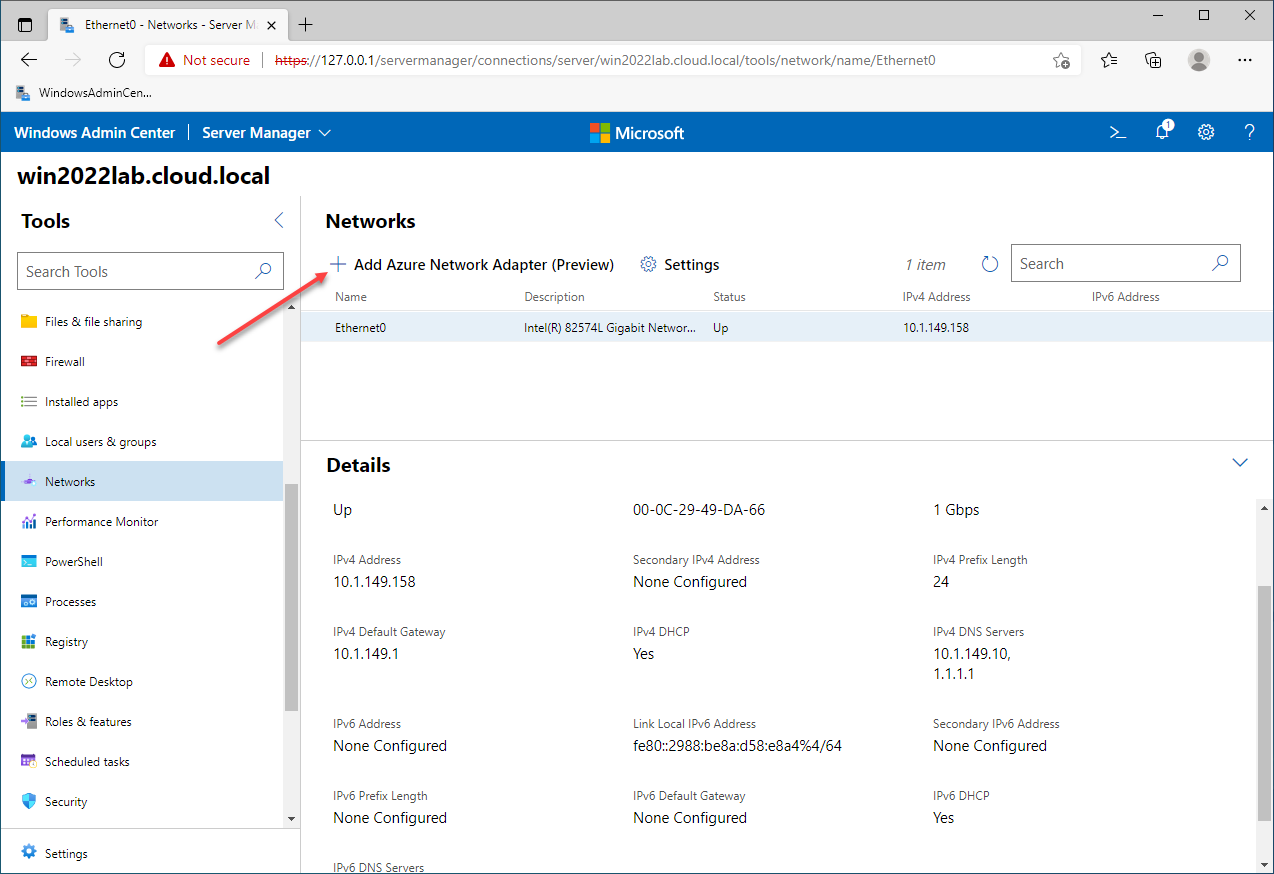 Configure Windows Server 2022 networking and Azure Network Adapter using Windows Admin Center
Configure Windows Server 2022 networking and Azure Network Adapter using Windows Admin Center
A few Windows Admin Center versions ago, Microsoft first introduced the new Performance Monitor extension, the first significant rewrite of this tool in decades. It looks fantastic and works on the concept of workspaces. However, the extension is still in preview form, so certain functionality is only available in the legacy Performance Monitor tool. In addition, you can save Performance Monitor workspaces for use at a later time.
 Using the new Performance Monitor in Windows Admin Center
Using the new Performance Monitor in Windows Admin Center
Another great built-in feature with Windows Admin Center is a built-in remote PowerShell extension. Using the PowerShell extension, you can easily access a remote PowerShell console to run commands on your Windows Server 2022 server.
As a side point, one of the great features of Windows Admin Center is the extensions proactively alert when an update for the extension is available. For example, as you can see below, the PowerShell extension has an update available. Thus, the lifecycle management of Windows Admin Center extensions is made easy by the built-in proactive updates.
 Access a remote PowerShell prompt with Windows Admin Center
Access a remote PowerShell prompt with Windows Admin Center
Instead of bringing up Task Manager, Processes have a dedicated extension for administration and management. For example, you can Start and End processes. However, it includes more advanced capabilities for troubleshooting and even provides functionality that you only find in tools from Sysinternals, including the ability to Find Handles. In addition, you can also create a process dump for troubleshooting.
These features will prove to be welcomed by administrators as they will have enhanced troubleshooting capabilities and visibility to processes on their Windows Servers.
 Monitor and manage Windows Server 2022 processes
Monitor and manage Windows Server 2022 processes
The look and feel of the Registry extension hold to the legacy registry editor in Windows. However, it has the modern, updated feel that helps to bring the tool forward into the future.
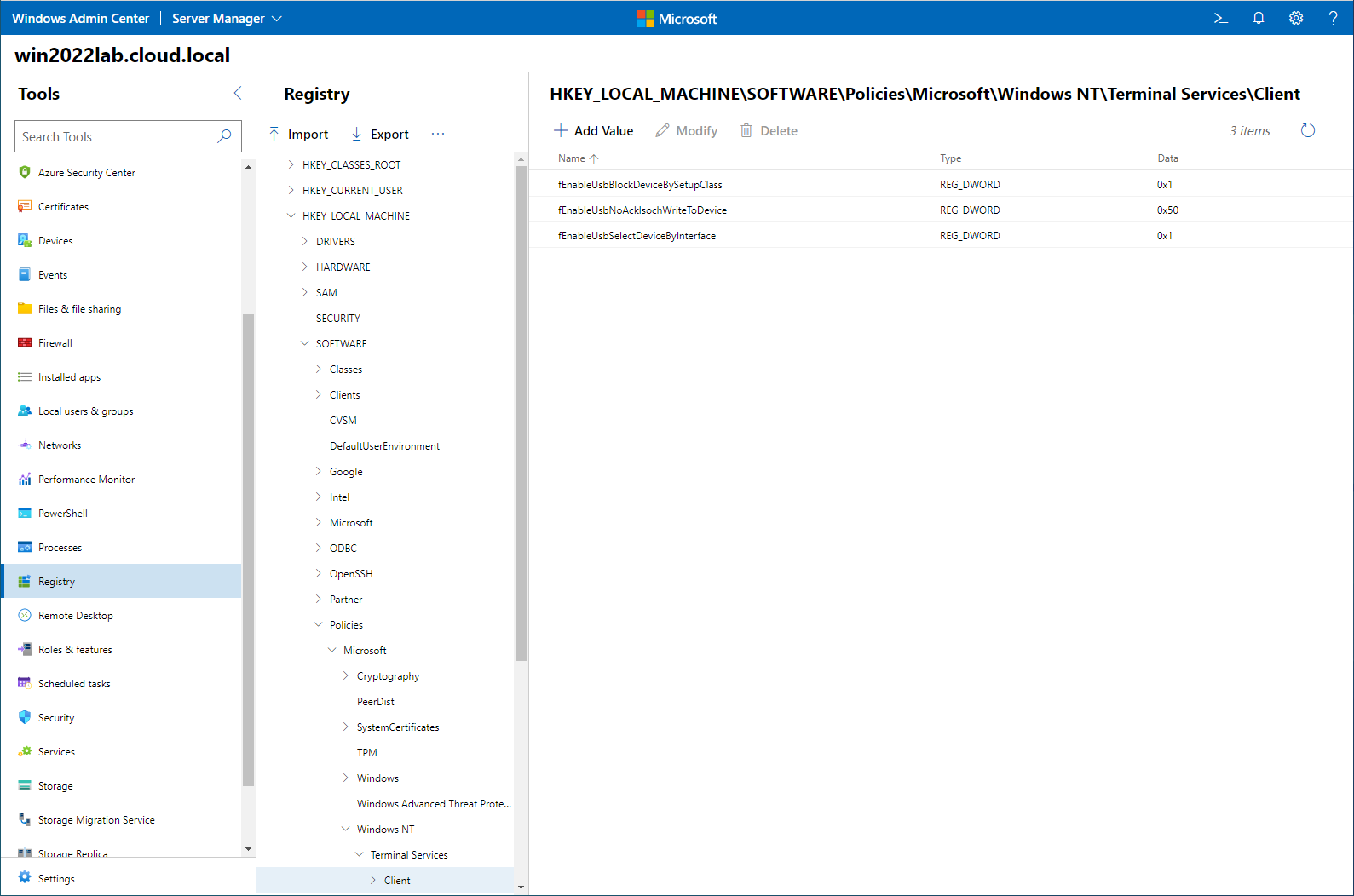 Edit the Windows Server 2022 registry
Edit the Windows Server 2022 registry
Managing Windows Firewall in Windows Server 2022 is easily handled by the Windows Admin Center Firewall extension. It allows managing Windows firewall rules, both incoming and outgoing. Also, a simple but great touch to the tool is the Search box to find rules quickly.
 Manage the Windows Server 2022 firewall
Manage the Windows Server 2022 firewall
What about managing software installed in Windows Server 2022? Windows Admin Center provides the Installed apps extension that offers similar functionality to Programs & Features to uninstall applications.
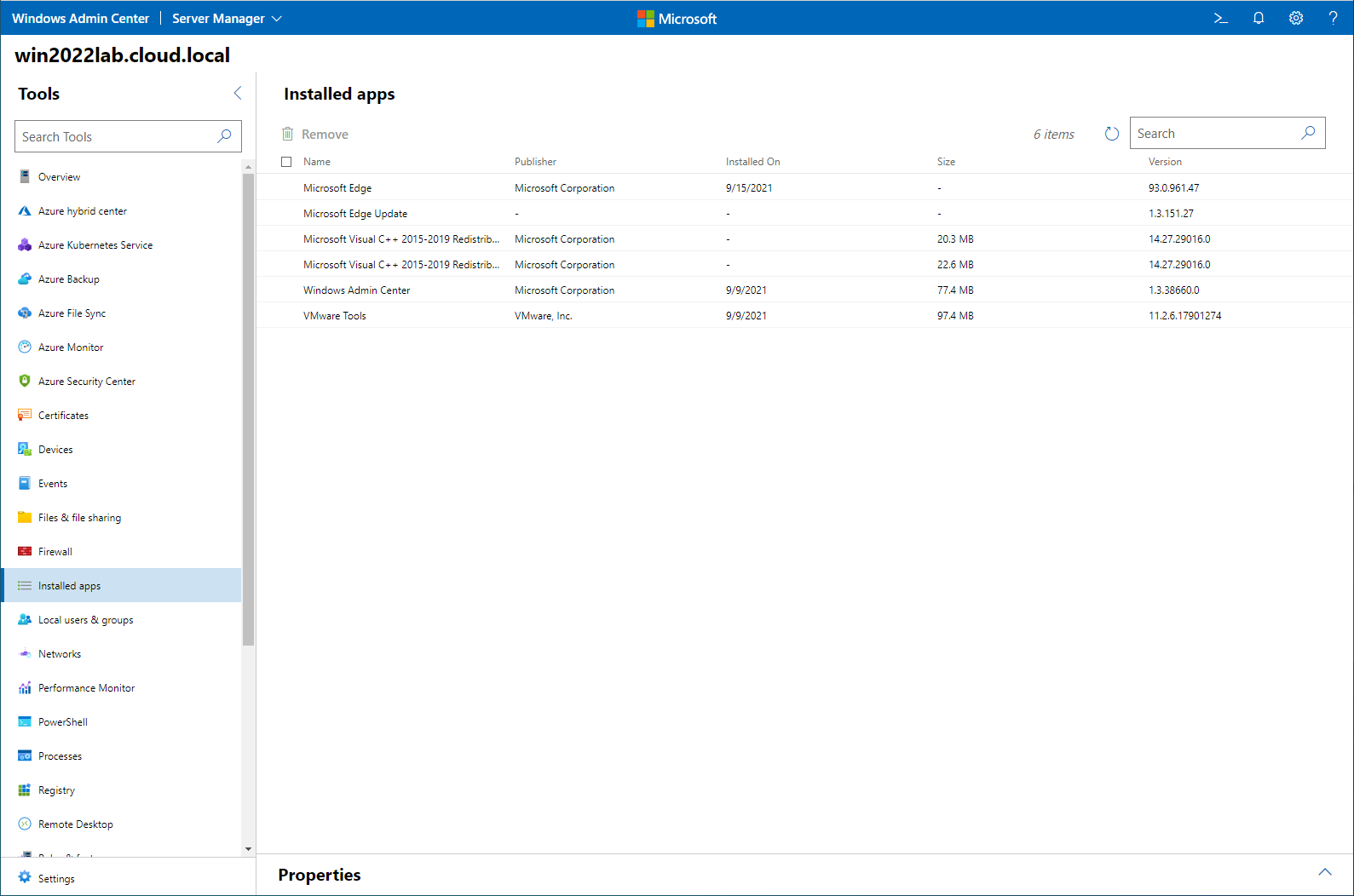 Manage installed applications in Windows Admin Center
Manage installed applications in Windows Admin Center
Scheduled tasks also have a new extension for managing Windows Server scheduled tasks to create, enable, disable, and start tasks. You also have a Search feature found in the scheduled tasks extension for quickly finding scheduled tasks listed in the extension.
 View and configure scheduled tasks
View and configure scheduled tasks
Windows Admin Center makes interacting with Windows services straightforward with the functionality that you would expect, including the ability to start, restart, pause, and change the settings of services. In addition, as is the case with other extensions, you can search in the upper-righthand corner. The search feature as part of the services extension makes finding an elusive service much easier.
 Manage Windows Server 2022 services
Manage Windows Server 2022 services
With Windows Server 2022, coupled with Windows Admin Center, you have robust storage information available at your fingertips. In addition, you can easily create volumes and interact with and manage VHDs. With Windows Admin Center, Microsoft has worked to provide health metrics throughout the tool. With the storage extension, Windows Admin Center also queries and calculates health metrics for storage devices.
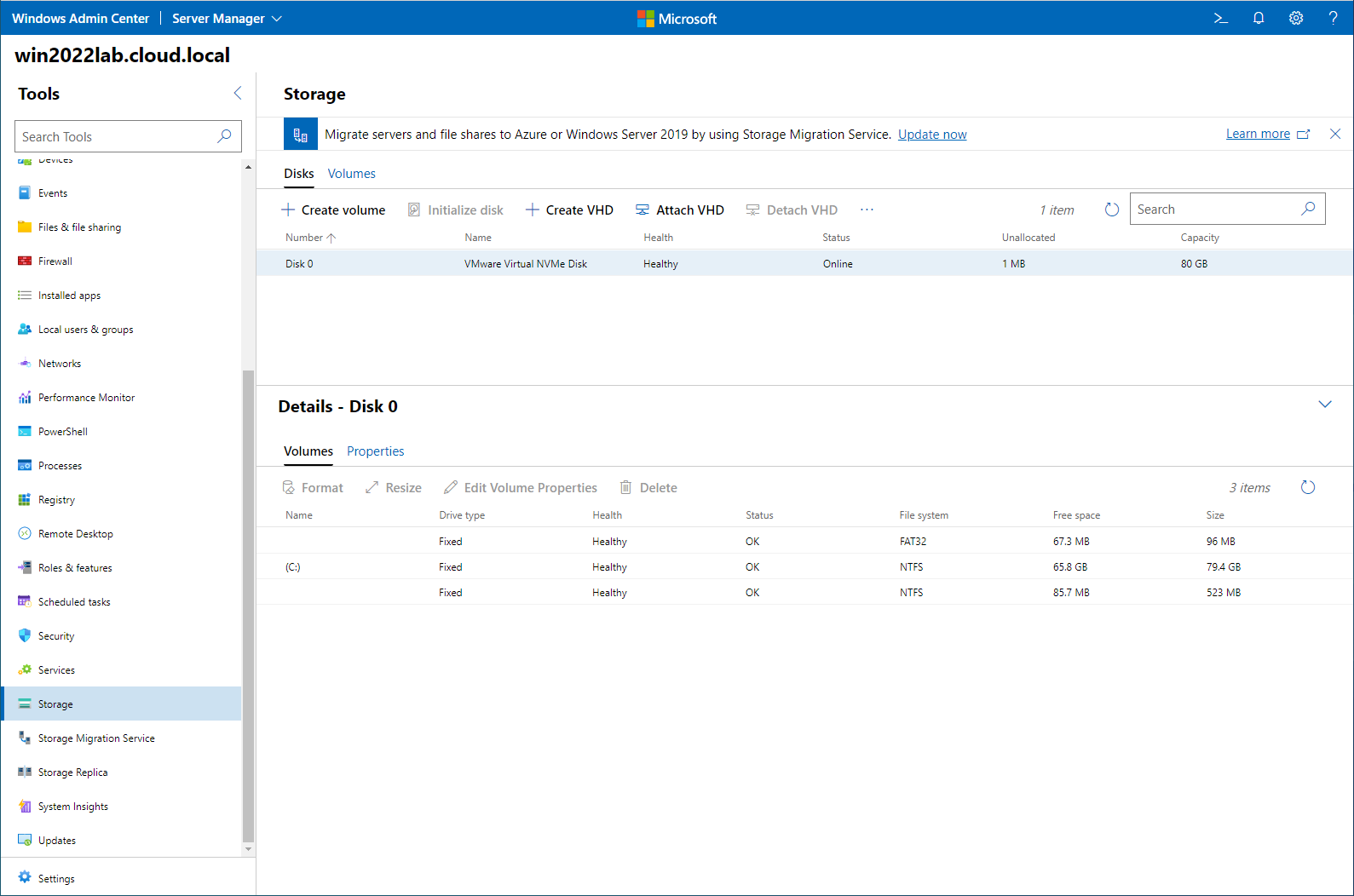 Manage Windows Server 2022 storage
Manage Windows Server 2022 storage
Windows Admin Center provides visibility to missing Windows Updates in the Update extension. With the extension, you will see available updates and update history. The information provided for each update is hugely beneficial, such as:
- MSRC Severity
- Mandatory
- Reboot required
With these additional columns, Windows Admin Center provides additional information readily available for IT admins to understand the full scope and severity of an available Windows Update.
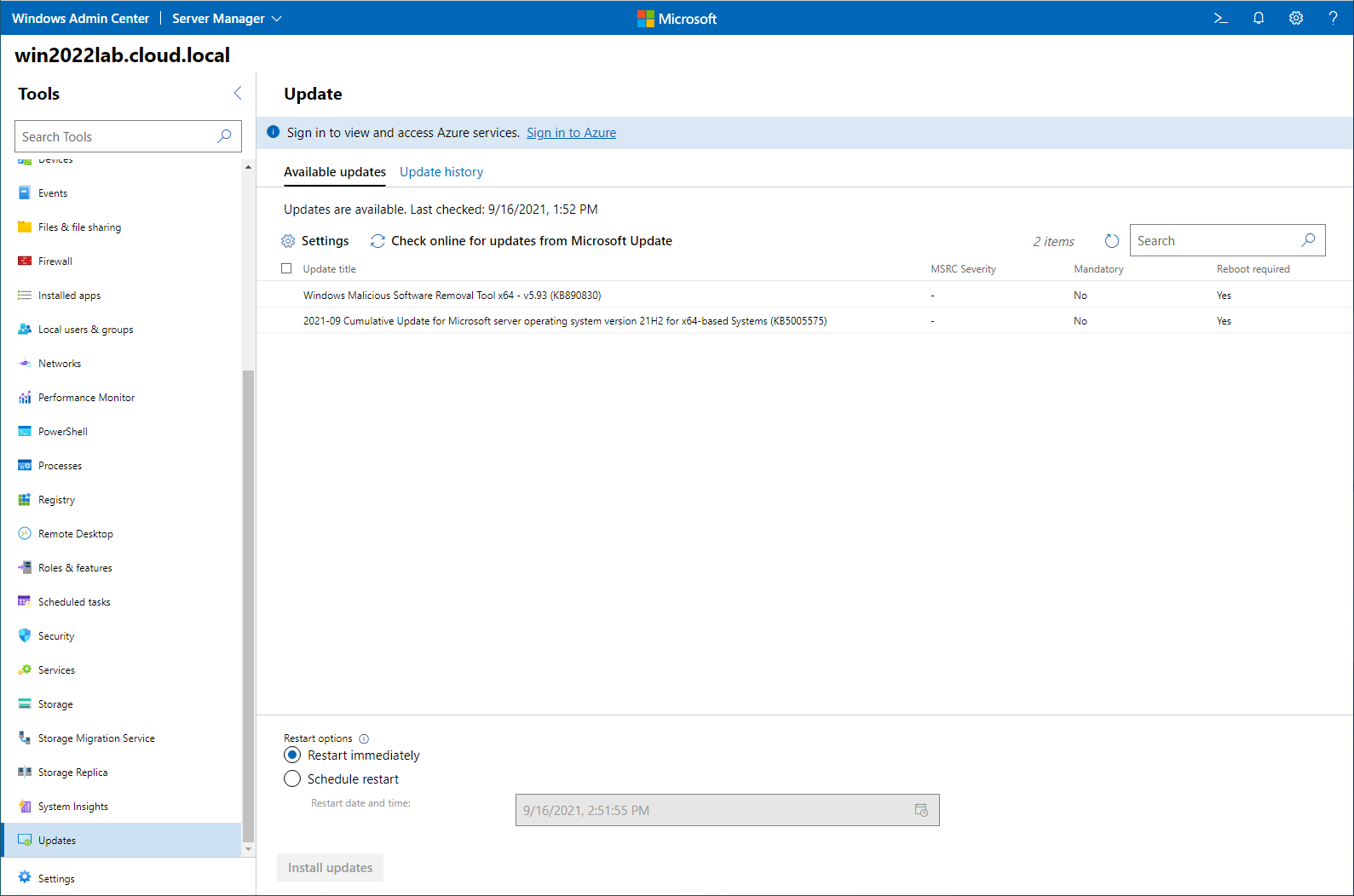 Manage Windows Updates using Windows Admin Center
Manage Windows Updates using Windows Admin Center
If you want to use a Remote Desktop connection to connect to your Windows Server 2022 server for management, you can navigate to the Remote Desktop extension. From Windows Admin Center, you can establish an RDP connection to your server managed by WAC.
 Access the Windows Server 2022 Remote Desktop
Access the Windows Server 2022 Remote Desktop
The Certificates extension provides excellent new functionality. For example, with the Certificates extension, at a glance, you can see the status of installed certificates. You no longer have to browse through your certificate stores to find all expired or nearly expired certificates. Instead, windows Admin Center provides this information in a single view, along with the standard import, export, renew, request new, and delete functionality.
Hybrid Cloud Services
Many hybrid cloud services are ready and available with just a few clicks in Windows Admin Center. These services include the following:
Extend on-premises capacity
- Azure File Sync
- Cloud Witness
- Create Azure VM
- Azure Extended Network
- Azure Network Adapter
- Storage Migration Service
Business continuity + disaster recovery
- Azure Backup
- Azure Site Recovery
- Storage Replica
Cloud intelligence to monitor, secure, update on-prem servers
- Azure Arc For Servers
- Azure Monitor
- Azure Security Center
- Azure Update Management
 Hybrid services available using Windows Admin Center
Hybrid services available using Windows Admin Center
Below are screenshots of a few of the abovementioned Azure services in Windows Admin Center. Azure File Sync allows creating an effective tiered storage solution for your organization with cold data stored in the cloud. It essentially creates a “bottomless” storage bucket for file storage.
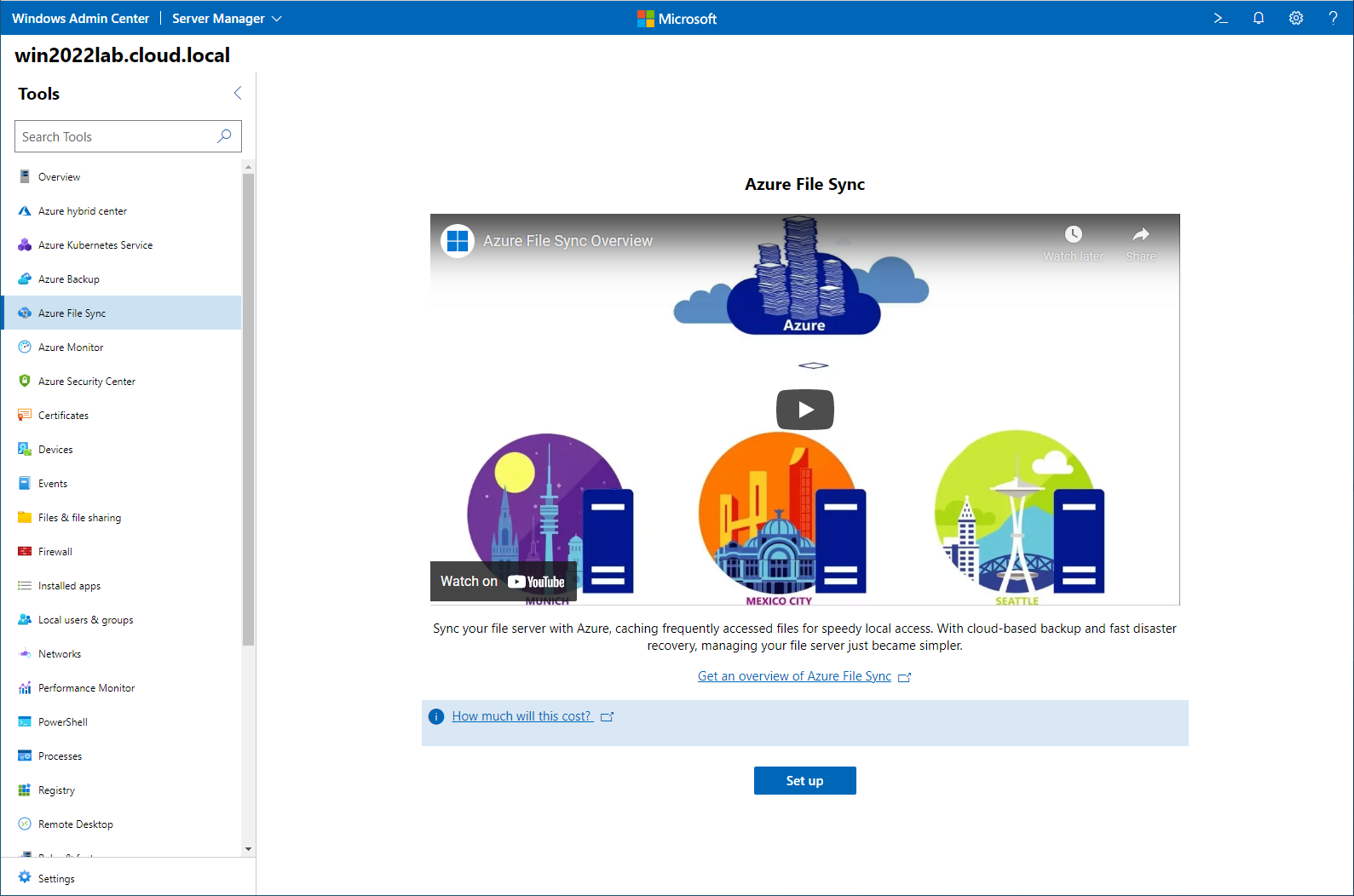 Azure File Sync available in Windows Admin Center
Azure File Sync available in Windows Admin Center
Azure Backup allows backing up your on-premises servers directly to Azure which has many benefits, including eliminating the need to procure, manage, and administer backup infrastructure on-premises.
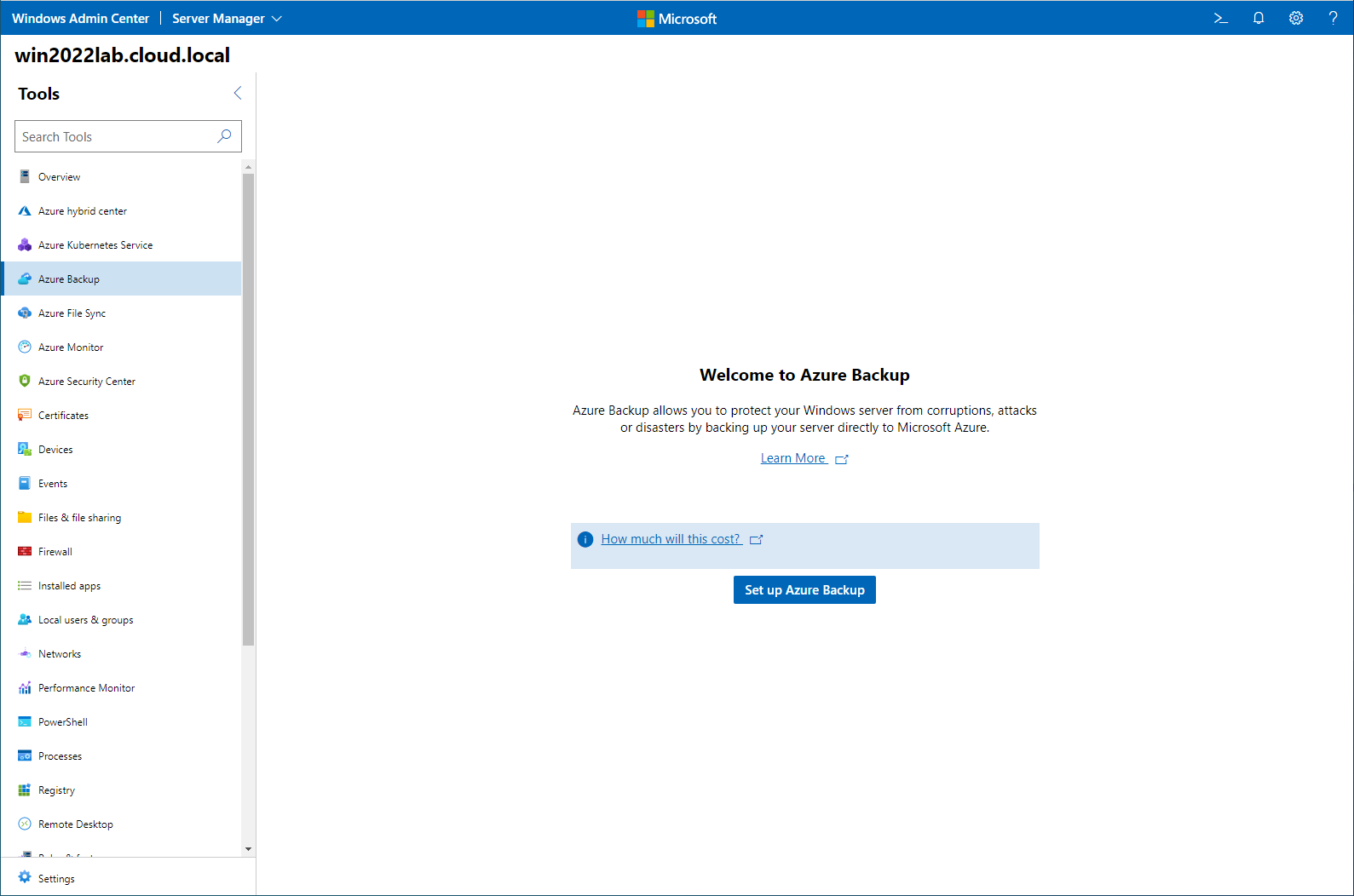 Azure Backup integration included in Windows Admin Center
Azure Backup integration included in Windows Admin Center
Azure Monitor allows collecting events and performance counters for analysis and reporting and then taking action on specific conditions detected. In addition, it enables receiving proactive notifications.
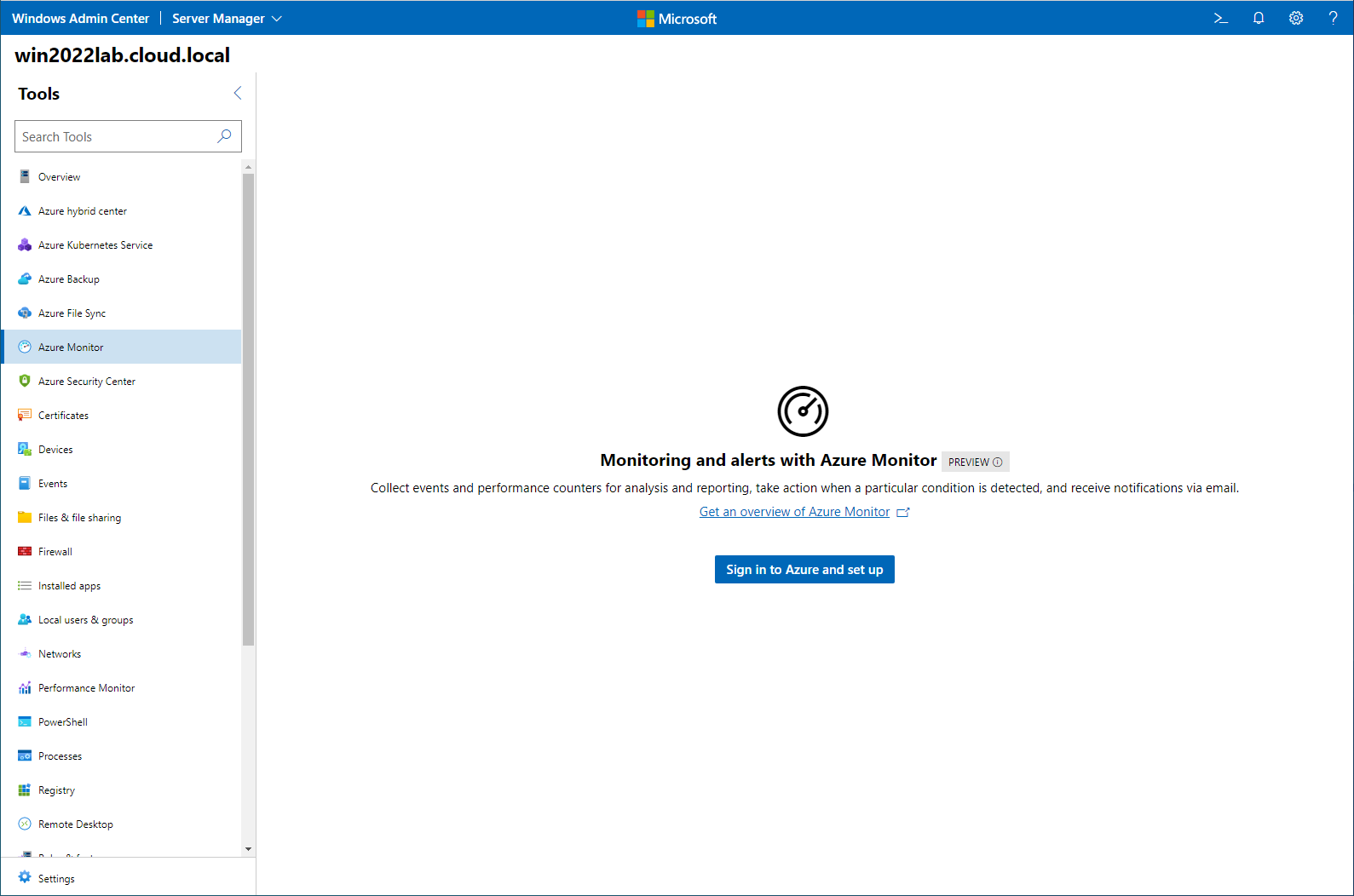 Configuring Azure Monitor in Windows Admin Center
Configuring Azure Monitor in Windows Admin Center
The hybrid integrations found in Windows Admin Center allow organizations to remove the complexities of integrating on-premises technologies with Azure solutions. It enables organizations to successfully make use of what Azure has to offer while at the same time maintaining on-premises Windows Server infrastructure.
Wrapping Up
Windows Admin Center is a game-changer with the release of Windows Server 2022. It provides the modern management tools to utilize the hybrid functionality of Windows Server 2022 to its fullest potential. In addition, it makes Windows Server Core a viable solution for the enterprise as there is no longer a blocker to management with Windows Server 2022 Core when using Windows Admin Center.
The solution is highly extensible and modular. In addition, it allows third-party solutions to write their extensions to integrate with Windows Admin Center. Finally, it will enable Microsoft to easily add new extensions as they have already, as time goes on.
Download Windows Admin Center directly from the Microsoft Evaluation Center here.


